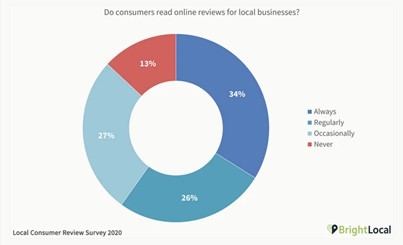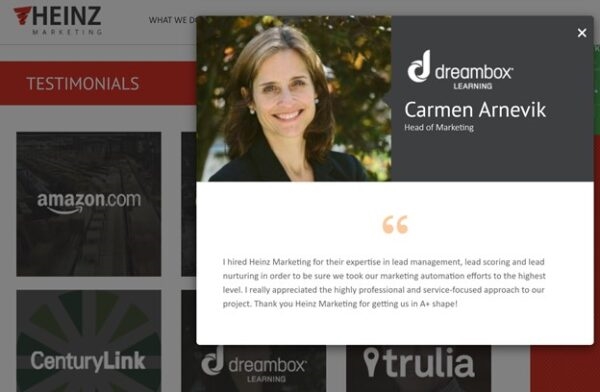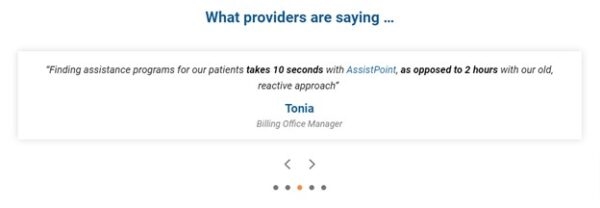As spring is becoming more spring-like in the Northeast, I’m itching (and so are my eyes) to plant flowers. Spruce up our yard. You might be doing some spring cleaning in your office. Seasonal maintenance on your marketing. As you examine what needs attention, consider a key component. Namely, customer testimonials.
Buyers are influenced by what other customers think, called social proof. So they seek feedback from others. According to a recent study, over 87% of consumers read online reviews for local businesses in 2020. The research shows feedback continues to be important, as the number steadily increases. For your info, the number was 67% in 2010!

The proportion of consumers that read online reviews for local businesses
BrightLocal 2020 Local Consumer Review Survey
If you optimized your customer testimonials, these gems would bring you more sales. Because there’s nothing as powerful as a testimonial in building trust and credibility. Also, a person sharing the positive and negative about your products and services is potent because it’s the voice of the customer.
“The quality of your testimonials is far more important than quantity.” Sam Holzman
Let’s look at 5 ways to optimize your testimonials.
5 Elements to Make Good Testimonials Better
-
Display image, name, and title
A buyer is determining whether he identifies with the customer giving the testimonial. If he does relate, he’s open to the person’s opinions. An image is the online equivalent to “putting a face to the name,” Photos and logos draw attention that simply text doesn’t do alone. The testimonials are also more memorable.
How do you overcome the perception the testimonial is fake? Enhance its credibility by being more transparent. Include an individual photo, job title, and company logo.
Heinz Marketing is a good example of this:

-
Furnish specific details
When a reader sees content that looks like everyone else’s, why would he read it? Sameness is easy to ignore. Remember, testimonials are also content. One way to combat obscurity is to use details in the testimonial. You want to share information that addresses your prospective customer’s objections, pain points, and problems. And you also want to include characteristics no other company can claim.
Sujan Patel, founder of Milkshake, suggests asking the right questions will help reveal insights buyers are seeking. So when a customer gives you some positive feedback, ask them how they’ve benefited from using the product. You’re looking for examples of how your product or service solved their problems and made their lives better.
Annexus Health addresses how a customer can save time, a familiar pain point:
-
Focus on the “before” and “after” in the testimonial
In marketing, we use storytelling because a good story grabs a buyer’s attention easily. It doesn’t sound salesy or manipulative. Chip and Dan Heath, authors of Made to Stick, say stories also drive action through simulation and inspiration.
A good testimonial that persuades a buyer to act is one that’s an engaging story. To peak interest, ask the customer to describe what life was like before buying the product. Then have the customer share the improvements after buying the product. Source
“The “before” and the “after” is the most important element of any testimonial because people buy products to solve specific problems, and they want to find out how somebody else’s life changed (for the better) after purchasing yours.” Sean D’Souza, Psychotactics
But avoid telling a tall tale. To improve authenticity, encourage customers to be realistic about their experience and the results. Testimonials written in normal, everyday language – instead of super-polished marketing-speak — will resonate with more prospective buyers.
-
Speak to your ideal buyer
A customer testimonial is more persuasive if a buyer recognizes the person behind the testimonial. Like attracts like. Identify the type of customer who perfectly fits your ideal. This may take some thought. Review your customer list. Who are your best customers? List the characteristics that make them ideal. It could be size of the company, products they buy, how long they’ve been in business or the industry, or the problems you’ve solved.
“No marketing material can build credibility better than a genuine, niche-specific customer success story told by someone similar to your target customer.” Sam Shepler, Testimonial Hero
-
Reveal data and statistics
The data and statistics included in a customer testimonial emphasize the proof in your “social proof.” If your customer is bragging about how their business is better, ask for numbers. Give the testimonial weight by showing measurable results.
“Every one of your marketing claims should be supported by evidence. And the easiest, most effective evidence you can add to a website is a testimonial.” Andy Crestodina, Orbit Media Studios
These 5 elements will help you improve your current customer testimonials. If you want the “before” and “after” formula, called The Makeover Formula, download the PDF here. It will help you gather and optimize testimonials quickly.
Now you know the elements you need when you collect future testimonials. Try using just one idea. A little polishing can bring in more sales-shine this month.
Digital & Social Articles on Business 2 Community
(57)
Report Post




